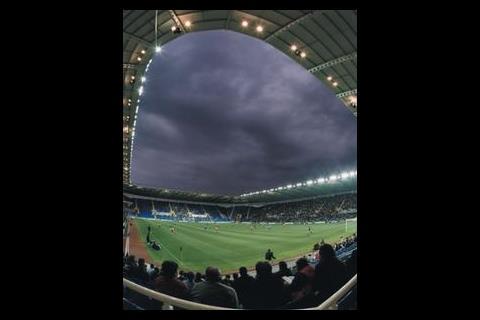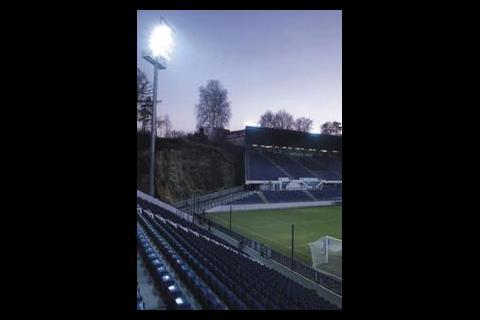This latest move to control the impact of outdoor lighting on surrounding areas signals a spreading awareness of light pollution and has become a major consideration in the design of lighting for stadia in the UK as well. "For smaller facilities such as local football clubs particularly, light pollution is a major issue and any light trespass outside the boundaries of the pitch onto adjacent properties is becoming a hot issue," observes Ian Major of Philips Lighting.
John Hugill of Thorn Lighting agrees: "Light pollution tends not to be a problem with major venues because the light generally remains within the confines of the stadia. On minor grounds with 30 to 40 floodlights, though, it is now a big priority to look at light pollution and to avoid it by using flat glass floodlights and aiming them carefully."
Aiming the floodlights carefully and using fixtures with precise photometric control is certainly part of the solution. The trend away from using tall corner towers to mounting floodlights on or under the roof of the stand also helps to contain the light.
"Over the last 10 years, stadia have been moving away from big corner towers to systems mounted on or under the roof of the stand," notes Ian Major. "This brings the floodlights into the roofline, which has aesthetic benefits as well as controlling the light and possibly giving higher lighting levels from the same energy input. Most planning authorities do not want to see big towers, though there are occasions when the architect makes a feature of them," he adds.
However, this relationship between the siting of the floodlights and the level of light pollution is not a hard and fast rule, as Kelvin Austin of Abacus Lighting points out: "Sometimes you will find less glare from a mast system than a side lighting system. For example, the Notts County and Notts Forest grounds are very close to each other and when both grounds are hosting a floodlit match at the same time it is easy to make a comparison. Surprisingly the floodlights on top of the Notts Forest grandstand are more visible with a huge corona, compared to the high mast system at Notts County. So the angle of the floodlighting and the elevations are very important," he suggests.
For larger stadia the requirements of colour television are the main driving forces, dictating the vertical illuminance levels for the camera, as well as colour rendering and colour temperature of the light sources. For international football matches, the vertical illuminance levels are dictated by FIFA. "The recommendations from FIFA are for a vertical illuminance to the main camera averaging 1400 lux, which generally equates to an on-pitch illuminance of 1800-2500 lux," Ian Major explains.
Colour rendering is also important because of the huge amounts of money spent on sponsorship. "If someone has paid a fortune on designer sportswear they want to ensure it's shown properly," John Hugill points out.
Consequently, the demands of the sponsors are a major factor in the choice of light sources. "Colour rendering has also improved with newer light sources - the minimum requirement is now 80 and some are as high as 90 – which is a vast improvement on the 65 of 10-12 years ago," he continues. "The light sources are almost exclusively metal halide though you may still find high pressure sodium in less serious applications such as local tennis courts," he adds.
The worst thing that can happen is to have a power cut that brings the television coverage to a halt, so there is a need of emergency back-up. This requires a generator and the use of hot re-strike lamps in at least some of the fittings, to maintain 800 lux vertical illuminance for the cameras. "The picture quality would suffer slightly but 800 lux is adequate for most of the television requirements," notes John Hugill.
Another consideration is the effect that narrower beams are having on the light above the ground. "As the light becomes more concentrated on the ground there is a danger of not being able to see the ball when it is in the air," notes Kelvin Austin.
Other types of stadia can be even more demanding than football stadia, especially where they are used for a variety of activities. With cricket the majority of light is concentrated on the centre of the pitch but if you want even illumination for other activities the very size of the stadium causes problems. At the Oval, for example, it would require 60 m high masts to achieve this, which would not go down well with the locals, so additional temporary lighting is brought in for non-cricket events.
Racecourses also have particular requirements: "We worked on a racecourse in South Africa recently where the specification included the need to avoid phantasmagorical lighting, where you get a flickering effect between light and shadow," John Hugill recalls. "If a horse sees a shadow it may think it is an object and try to jump it. To overcome this you have to light across the track and towards the horses, while keeping the glare down," he adds.
So complex is the design of lighting for stadia, most clients and consultants leave the detailed design to the specialist manufacturers. "Stadium lighting involves a lot of detailed calculations so in most cases these are left to the manufacturers – who have the software and the experience to do this," says Kelvin Austin.
Like specification in every other area of building services, there tends to be a bit of spec-breaking as the project proceeds. "The specification tends to be tight when you start the project but as money becomes an issue there is a tendency to move away from it," Kelvin Austin warns. "There is a particular problem with certain American companies with fixtures that are based on a 1970s design and of a lower specification than European fittings. Some of them aren't even CE rated but because they are cheaper they win the contract.
"One of the problems with some of these is that different lighting levels are achieved by taking tappings off the ballasts and running different currents through the lamps, which shortens the life of the lamp," he adds.
John Hugill has encountered similar problems: "The old fashioned American fittings using jacketed lamps can give very poor control of light and some of them are sensitive to lamp orientation, so the aiming angle will vary the light output."
As more and more money is spent on new stadia throughout the world, and the owners of those stadia want to get the maximum returns on their investments, the demands on the lighting will increase. More precise designs, flexibility of positioning and the ability to vary lighting levels are all factors that will enable the lighting designers to meet the needs of their clients.
Source
Building Sustainable Design
Postscript
Paul Haddlesey is editor of Lightseek.com























No comments yet